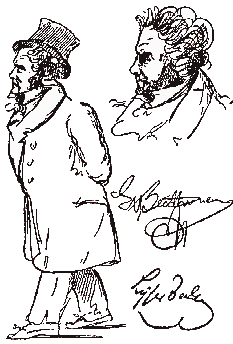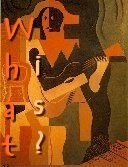|
|

"Norrington: that is something the Victorians and the
puritans and the followers of Ajiatolah just can't understand; that you
may be deeply serious and humorist at the same time. That is the point
of the issue. I think that this idea, that music should be sehr ernst and
not an occasion for humor, started from the Victorian epoch, when music
was an upper class activity, which distinguished you from the troglodytes. Besides this, the time all this gravity got started was the time in which
religion was indeed too much questioned, and for a while music attained
the significance of a religion —it acquired stained-glass windows — and
Wagner was the archpriest. It now was the ‘mystical world of German music',
it ought to seem difficult, heavy, an embodiment of the authentic — everything
Beethoven reproved. And of course, any one authority standing up and saying
‘we are right, my child', I can not bear."
Besides this, the time all this gravity got started was the time in which
religion was indeed too much questioned, and for a while music attained
the significance of a religion —it acquired stained-glass windows — and
Wagner was the archpriest. It now was the ‘mystical world of German music',
it ought to seem difficult, heavy, an embodiment of the authentic — everything
Beethoven reproved. And of course, any one authority standing up and saying
‘we are right, my child', I can not bear."
Thus, the re-antiquating cries for a return to the authentic past laboriously but unsuccessfully try to cover up a variety of shallow and arbitrary ideas, and in Norrington's case the mixture of trifling existentialism and cafeteria-revolutionism. The first is not so provocative, as dangerous the second is: the uncompromising saviors are unmasked as servants of despotism, reminding us that contempt for the transcendent and always unexplainable meaning has always been the illness which gives birth to despotism and exploits it in order to infect everything. The sonic aspect of the corruption promoted by the re-antiquating movement, is very well described by Samuel Lipman:
As one makes one's way through Norrington's recordings
of the Beethoven symphonies, one soon recognizes that they indeed sum up
the authentic-performance movement. Here, to begin with, are all its characteristic
tonal features: string sounds, especially when unaccompanied by the other
sections of the orchestra, reminiscent of what is produced by a harmonium;
raucous wind playing, by turns muffled and shrieking, tympani sounds resembling
what happens when a bean-bag is dropped on a tabletop. Overall balance
between sections, assisted by the weakness of the string playing and by
the brute force of (especially) the trumpets and the horns, so favors the
winds and the brass that essential melodic features when played by the
strings (the opening theme of the Eighth Symphony is a case in point are
often blotted out. Taken together, these attributes produce a choked, clipped
sonority dependent on the booming acoustics of the recording space and
on the addition of electronic resonance for any life whatsoever. (...)
short note durations; much attention to detached playing in fast passages; strident accentuation; over-regular organization by bar-lines as a substitute
for the natural flow of melodies. Tempos, as always proudly fulfilling
Beethoven's own metronome markings, seem most strikingly to be chosen from
a range restricted to fast, faster, and fastest. (...) almost all the time
—the foundation of the performance (...) is the tick-tock of the metronome. (...) All the reviewers, it is true, speak of the coruscating excitement
they seem to get out of Norrington's work, but this verdict only proves
how indistinguishable in modern criticism true excitement is from mere
panic.
PAST works are like the souls in Homer's nekyia: to speak they must first drink blood; how then are we going to understand them? Let not the fatal eye of the above us gods' love grasp me — isn't this our own song?

Acknowledgements
A good introduction to the issues concerning the authenticist movement is offered by Charles Rosen's "The Shock of the Old", published in The New York Review of Books, July 19, 1994; it is a review of an anthology titled Authenticity and Early Music: A Symposium (ed.Nicholas Kenyon). The Wall and the Books has been translated in Greek many times; I used G. D. Churmousiades' translation, included in the anthology of Borges' essays and short stories The transformations of the tortoise.
Hanna Arent: reference to The Human Condition (Vita Activa), translated in Greek by Steph. Rozanes and Ger. Lykiardopoulos. Stravinsky's Musical Poetics: after the Greek translation by M. Gregoriou. Seferis: from his exceptional commentary on Makrygiannis, included in the first volume of his essays. The exile of the poets: reference to the tenth book of Plato's Republic. I saw the fragment of Norrington's interview (Gramophone, April 1989), in Samuel Lipman's article "Cutting Beethoven down to size" in Commentary, February 1990; from the same article comes the description of the re-antiquating sound. The ancient word: Prometheus Bound; The original Greek text (transliterated): "Mede kreissonon theon eros afycton omma prosdrakoi me."
Reference address of this text (first page): https://www.ellopos.net/music/library/authenticity.html
First
published at Epopteia magazine, v. 168, June 1991
"What is music?" home address: https://www.ellopos.net/music/library/
|
|
 Besides this, the time all this gravity got started was the time in which
religion was indeed too much questioned, and for a while music attained
the significance of a religion —it acquired stained-glass windows — and
Wagner was the archpriest. It now was the ‘mystical world of German music',
it ought to seem difficult, heavy, an embodiment of the authentic — everything
Beethoven reproved. And of course, any one authority standing up and saying
‘we are right, my child', I can not bear."
Besides this, the time all this gravity got started was the time in which
religion was indeed too much questioned, and for a while music attained
the significance of a religion —it acquired stained-glass windows — and
Wagner was the archpriest. It now was the ‘mystical world of German music',
it ought to seem difficult, heavy, an embodiment of the authentic — everything
Beethoven reproved. And of course, any one authority standing up and saying
‘we are right, my child', I can not bear."

